5 Books To Help You Do User Research Better
Any market-focused firm needs user research to understand user behavior. When building a product, for you to harness the design process, you have to know which techniques and metrics to use. All these can be achieved by conducting user research. It involves understanding how the target audience uses products and discovering design gaps to fulfill their needs. User research is vital for customer-centric product development. It ensures the optimal user experience, which boosts customer happiness and customer loyalty. This article reviews five user research books that can help you do research better.
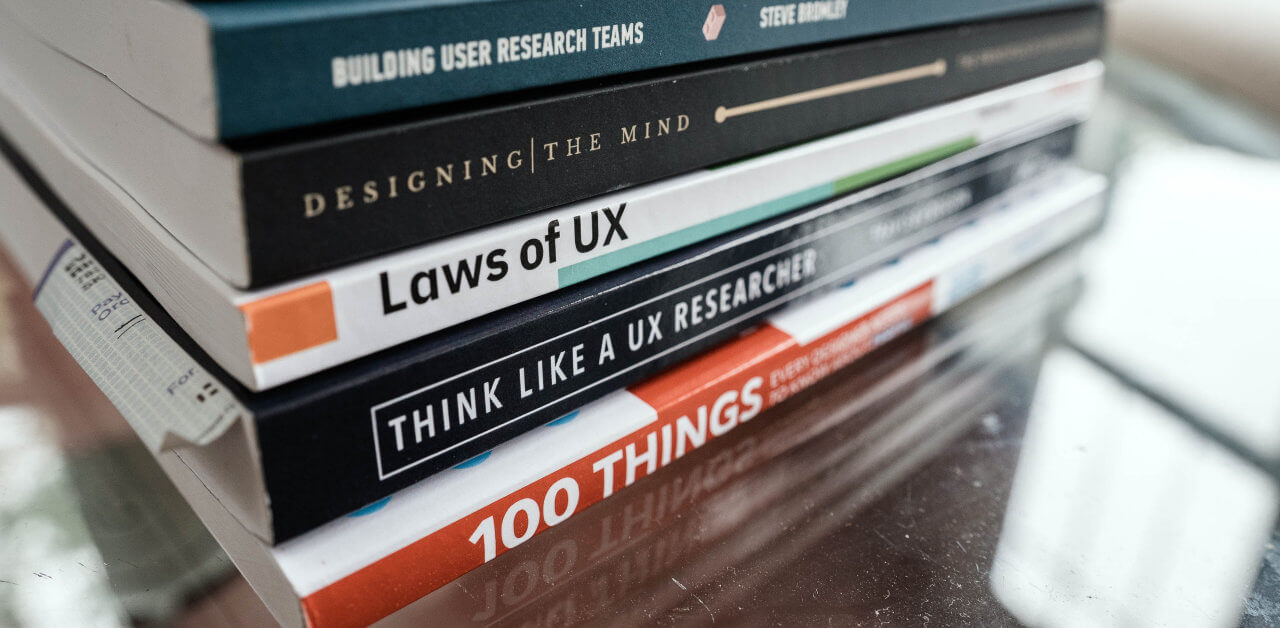
1. “Just Enough Research” by Erika Hall
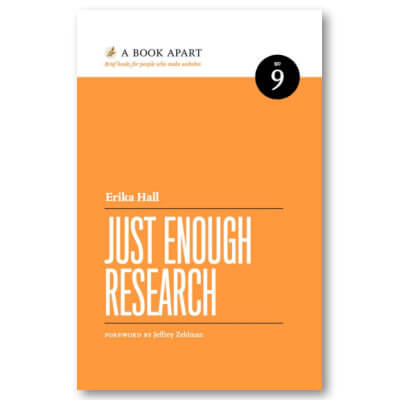
“Just Enough Research” is a book by Erika Hall, the co-founder of Mule Design. This book is packed with a wealth of knowledge and vast information on user research. It discusses research types and methods.
This book is great for anyone who wants to learn how to conduct user research and map the customer journey. It provides practical guidance on how to design research studies that are efficient, effective, and impactful. The book covers topics such as selecting the right research methods, creating research questions, and analyzing and presenting research findings.
One of the key strengths of “Just Enough Research” is its emphasis on the importance of empathy and human-centered design. The author stresses the need to understand the people you are designing for and to use research to guide the design process. The book also includes a helpful appendix with templates for research planning, data collection, and analysis.
The author emphasizes user research and provides tools and frameworks to speed up your approach. Erika discusses further how to avoid using assumptions when conducting research. She says,
“Your desire to find out needs to be stronger than your desire to predict. Otherwise, you will be a mess of confirmation bias, looking for answers that confirm what you already assume.”
This book will help you:
- Identify your biases and blind spots,
- Identify your competitive advantages,
- Integrate UX research approaches into the design process.
2. “Handbook of Usability Testing” by Jeffrey Rubin and Dana Chisnell
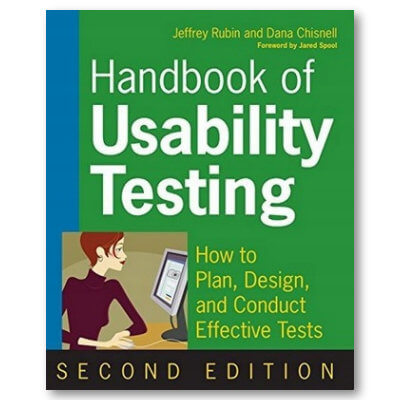
The “Handbook of Usability Testing” by Jeffrey Rubin and Dana Chisnell is a comprehensive guide to planning, conducting, and analyzing usability testing. This book is considered a classic reference in the field of user research and is widely used by practitioners and students alike.
The book is organized into four main sections. The first section provides an overview of usability testing, including its benefits, challenges, and key concepts. The second section covers planning and preparing for usability testing, including defining goals, selecting participants, and creating test materials. The third section covers conducting usability tests, including moderating sessions, collecting data, and interpreting results. The final section covers analyzing and reporting usability test results, including creating reports and communicating findings to stakeholders.
One of the strengths of the “Handbook of Usability Testing” is its emphasis on practical guidance and real-world examples. The authors provide numerous case studies and examples of applying usability testing in different contexts and for different types of products and services. The book also includes many templates, checklists, and other tools that can be used to plan and conduct usability tests.
This book focuses on the importance of user-centered design. The authors stress the need to involve users in the design process and to use research to guide design decisions. They also emphasize the importance of testing early and often to identify problems and make iterative improvements.
Overall, the “Handbook of Usability Testing” is an essential resource for anyone who wants to learn how to plan, conduct, and analyze usability tests. It is highly practical and provides a wealth of guidance and tools for conducting effective user research.
3. “Interviewing Users: How to Uncover Compelling Insights” by Steve Portigal
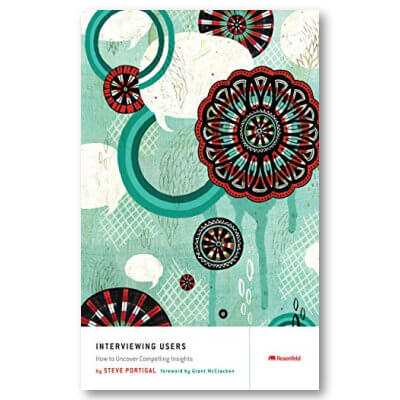
“Interviewing Users: How to Discover Compelling Insights” by Steve Portigal is a detailed guide to user interviews. The book challenges traditional thinking and provides helpful advice, tactics, and resources for conducting intelligent interviews. Below is a list of why you should read this book:
- The book emphasizes interviewing properly. Poorly prepared and executed interviews can yield irrelevant or erroneous data. Steve Portigal stresses preparation, rapport, and asking the appropriate questions.
- It emphasizes interview storytelling. Stories reveal users’ ideas, intentions, and actions. Interviews should reveal the user’s story and gather essential data.
- It explains the necessity to switch interviews from information gathering to data collection. Data collection avoids obtaining irrelevant data.
- It covers interview preparation, execution, and analysis. Asking open-ended questions, listening intently, and observing body language are also covered.
Overall, “Interviewing Users” is a valuable resource for anyone who wants to learn how to conduct effective user interviews. It is highly actionable and provides practical guidance on how to conduct interviews in a way that produces useful and actionable insights. The book emphasizes the importance of empathy, curiosity, and storytelling in user research, which are key skills for any user researcher.
4. “User Experience Team of One: Research and Design Survival Guide” by Leah Buley
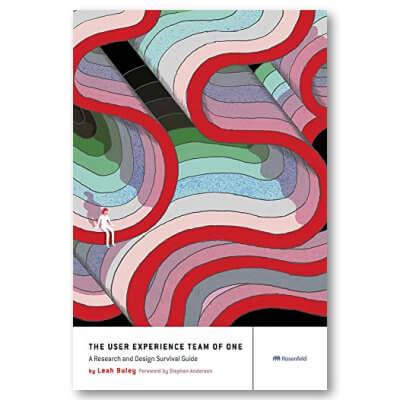
The “User Experience Team of One: Research and Design Survival Guide” by Leah Buley is a practical guide for user experience professionals who work on small teams or as the sole user experience practitioner in their organization. The book guides planning and conducting user research, designing and iterating on user interfaces, and communicating design decisions to stakeholders.
One of the key strengths of “User Experience Team of One” is its focus on how to be effective in a resource-constrained environment. The author provides many tips and tricks for conducting research and design activities with limited time, budget, and resources. She also emphasizes the importance of being strategic and prioritizing activities with the most impact.
This book covers various topics, including user research, design thinking, prototyping, and usability testing. The author provides practical guidance on how to conduct each of these activities in a way that is efficient and effective. She also provides many real-world examples and case studies that illustrate how to apply these techniques in different contexts.
This book focuses on collaboration and communication. The author stresses the importance of building strong stakeholder relationships and working collaboratively with other teams to achieve design goals. She provides many tips and strategies for communicating design decisions to stakeholders and getting buy-in for design solutions.
Simply put, The User Experience Team of One is a great resource for solo or small-team UX practitioners. It includes a detailed explanation of UX, practical guidance on personal and professional growth, and a variety of methods for creating customer-centric products. This book is essential for UX research and design survival.
5. “Think Like a UX Researcher: How to Observe Users, Influence Design, and Shape Business Strategy” by David Travis and Philip Hodgson
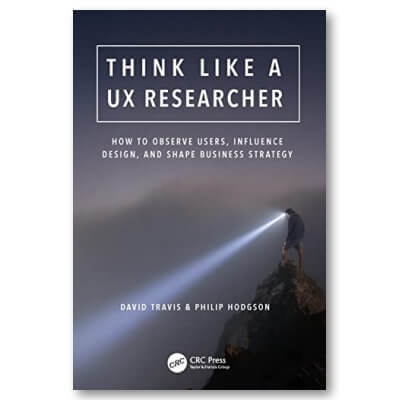
“Think Like a UX Researcher” is a comprehensive guide to user experience research that offers practical guidance on planning and conducting research, analyzing data, and communicating insights to stakeholders. It emphasizes the importance of user-centered design, involving users throughout the design process and using research to guide design decisions.
One of the book’s strengths is its focus on the business impact of user research. The authors stress the importance of using research to drive business strategy and make data-driven decisions, communicating the value of user research to stakeholders and getting buy-in for research activities.
This book covers various research topics, including qualitative and quantitative research methods, planning and conducting research studies, and analyzing and communicating research findings. The authors provide many real-world examples and case studies illustrating how to apply these techniques in different contexts.
Each chapter’s exercises, thought triggers, and situations make the book valuable. They reinforce and test your UX research knowledge. Practical, real-world exercises make it easier to apply what you learn. The book’s practical suggestions and current examples help you perform user research better. The writers share UX research best practices from their significant experience. They also demonstrate how companies have improved their products and services via UX research.
Another strength of the book is its clear and accessible writing style. The authors avoid jargon and provide many practical tips and tools for conducting research. They also guide how to avoid common mistakes and pitfalls in research.
Veteran researchers share their experiences adjusting UX methodologies to their organizations in the book. Think Like a UX Researcher is useful for improving user experience through UX research. It offers practical advice, activities, and real-world situations. This book will teach you how to perform UX research that informs design and business strategy.
Final Thoughts
Each book reviewed provides a unique perspective and tools for conducting effective research and designing user-centered products and services. From practical tips on conducting interviews and usability tests to guidance on communicating research findings to stakeholders, these books cover a wide range of topics relevant to anyone working in the field of user experience.
Whether you’re new to user research or an experienced practitioner, these books offer valuable insights and strategies that can help you improve your research and design skills. By applying the principles and techniques outlined in these books, you can create products and services that better meet the needs and preferences of users and drive business success.
About the Author

Amrapali Rai is a freelance SEO strategist and content writer who works with brands and SaaS companies to support their SEO and content strategy at Bazaar Expert.






